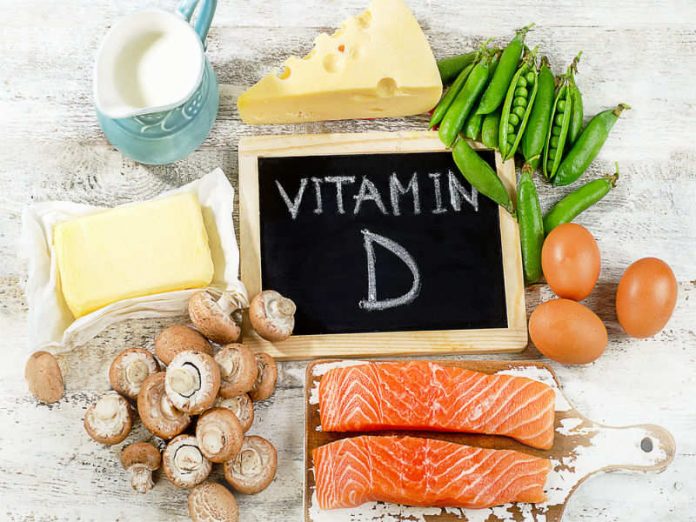Test Values and Treatment for Vitamin D Deficiency
I believe there are compelling reasons to really make a concerted effort to get ALL your vitamin D requirements from exposure to sunshine or by using a safe tanning bed.
However, if neither of these are feasible options, then you should take an oral vitamin D3 supplement.
Before considering supplementation with vitamin D, it would be wise to have your vitamin D level tested, and regardless of the method you use, it’s important to measure your levels from time to time to make sure you’re maintaining therapeutic levels year-round.
This is best done by a nutritionally oriented physician, as it is very important that they order the correct test.
The advantage of having your medical doctor perform the test is that it will usually be covered by your medical insurance.
Don’t Be Fooled — Order the Correct Test
There are two vitamin D tests — 1,25(OH)D and 25(OH)D.
The correct test is 25(OH)D, also called 25-hydroxyvitamin D. This is the better marker of overall D status, and is most strongly associated with overall health.
Please note the difference between normal and optimal. You don’t want to be average here; you want to be optimally healthy. Primitive man likely developed in tropical and sub-tropical conditions with large exposure to UV-B and its secondary consequence to skin exposure, vitamin D. Primitive environmental availability of a nutrient does not necessarily establish the higher requirements, but these exposures would have influenced the evolution of the relevant physiology, and such concentrations should at least be considered presumptively acceptable.
Some experts may disagree with the following ranges, but they are taken from healthy people in tropical or subtropical parts of the world, where they are receiving healthy sun exposures. It seems more than reasonable to assume that these values are in fact reflective of an optimal human requirement.
Make Sure Your Lab Uses the Correct Assay
There are a number of different companies that have FDA approval to perform vitamin D testing, but the gold standard is DiaSorin. Their radioimmunoassay (RIA) method for measuring total vitamin D levels has become the gold standard, not because it’s more accurate than the others, but because it’s the one used in almost every major vitamin D study, on which the recommended blood levels for clinical efficacy are based.
If you’re in the United States, it is my strong recommendation to use tests that are either from Lab Corp, or the blood spot test that Grassrootshealth.net uses, which you can do via mail.
Dosing Recommendations for Oral Vitamin D
There is no one-size-fits-all dosage level at which “magic” happens, but based on the most recent research by GrassrootsHealth—an organization that has greatly contributed to the current knowledge on vitamin D through their D* Action Study—it appears as though most adults need about 8,000 IU’s of vitamin D a day in order to get their serum levels above 40 ng/ml. This is significantly higher than previous vitamin D recommendations!
For children, many experts agree they need about 35 IU’s of vitamin D per pound of body weight.
At the time GrassrootsHealth performed the studies that resulted in this increased dosage recommendation, the optimal serum level was believed to be between 40 and 60 nanograms per milliliter (ng/ml). Since then, the optimal vitamin D level has been raised to 50-70 ng/ml, and when treating cancer or heart disease, as high as 70-100 ng/ml, as illustrated in the chart above.
What this means is that even if you do not regularly monitor your vitamin D levels (which you should), your risk of overdosing is going to be fairly slim, even if you take as much as 8,000 IU’s a day. However, the only way to determine your optimal dose is to get your blood tested regularly, and adjust your dosage to maintain that optimal range.
Remember, unless you get a deep dark tan, which is a pretty good indicator that your vitamin D levels are where they need to be, it is wise to get your blood levels checked — that is the only way to know for certain you have reached therapeutic levels.
Supplement with the Correct Vitamin D
There are two types of vitamin D supplements: vitamin D3 (cholecalciferol), which comes from fish oil, and plant source D2 (ergocalciferol), which is found in fortified foods and some supplements. D2, found in plants and made active by irradiation, is less biologically active.
Vitamin D3 is found in eggs, organ meats, animal fat, cod liver oil, and fish. It is equivalent to the vitamin D3 formed on your skin from UV-B. You should stay away from the synthetic D2 as it has been shown to be toxic at the higher dose ranges.
You will only want to use vitamin D3 (cholecalciferol).
A meta-analysis by the Cochrane Database1, which looked at mortality rates for people who supplemented their diets with D2 versus those who did so with D3, highlights the importance of using the correct type. The analysis, which included 50 randomized controlled trials (a total of 94,000 participants), found:
- A six percent relative risk reduction among those who used vitamin D3, but
- A two percent relative risk increase among those who used D2
There are additional reasons why vitamin D2 has a greater potential for harm. First, vitamin D binding protein has a weaker affinity for the vitamin D2 metabolites than vitamin D3. Second, unique, biologically active metabolites are produced in your body from vitamin D2, but there are no analogous metabolites derived from vitamin D3. There is no doubt that vitamin D2 is a synthetic analogue of vitamin D, with different characteristics. But it is inappropriate to regard vitamin D2 as a vitamin. Future research into the toxicity of vitamin D needs to focus on vitamin D3 as being something distinct from vitamin D2, for which almost all our current toxicity data relate to.
People Who Should Avoid Vitamin D
If you have sarcoidosis, tuberculosis, or lymphoma, it would be best for you to avoid oral vitamin D supplementation based on this test. It is recommended that you perform the 1,25(OH)D test before you supplement with any sun exposure or oral vitamin D, as it is a better indicator in people with this health challenge.
How Vitamin D Is Generated in Your Skin
Ideally, the best place to get vitamin D is from your skin being exposed to the sun’s UV-B rays. Vitamin D from sunlight acts as a pro-hormone, rapidly converting into 25-hydroxyvitamin D, or vitamin D3.
UV light is divided into three bands or wavelength ranges, which are referred to as UV-A, UV-B and UV-C.
UV-B is sometimes called the “burning ray.” It’s the primary cause of sunburn caused by overexposure to sunlight. However, UV-B sunlight also produces vitamin D in your skin. The amount produced depends on exposure time, latitude and altitude of location, season, amount of skin surface exposed, and skin pigmentation. UV-B also stimulates the production of MSH, an important hormone in weight loss, energy production, and in giving you that wonderful tanned appearance.
However, UV-B does not penetrate very deeply into your skin. The darker the pigmentation or more tanned your skin, the less UV-B penetrates. Other things that influence UV-B penetration include window glass and use of sunblock. Window glass allows only five percent of the UV-B light range that produces vitamin D to get through your home or car. Sunblock can block UV-B penetration drastically or entirely.
Sunlight Is Your Ideal Source of Vitamin D
Unfortunately, the amount of sun reaching most of the U.S. is only sufficient to generate a healthy vitamin D response for far less than half of the year. Most people don’t live far enough south or high enough in the mountains to allow enough UV-B to reach their skin. So, for those times of the year when access to the proper amount of sun is not possible, you will want to consider an oral form of vitamin D3 (cholecalciferol).
For instructions on how to determine your yearly window of opportunity, during which time you can get sufficient amounts of vitamin D from the sun based on your individual location, please watch the following video. It is important to know your level of UV-B exposure. The typical American strategy “more is better” is not the case for UV-B exposure. Longer exposure will not increase vitamin D production, but will increase your danger of skin damage and possible skin cancer, so only expose yourself to the sun when UV-B’s are actually present in your given location—otherwise you’re simply increasing your risk of skin damage.
Major Caution: Avoid Sunburn
It is important to stress that you should never get burned and should only implement sun exposure very gradually. While we all benefit from regular exposure to the sun, it is important to recognize that you should always limit your exposure so that you avoid getting burnt. Sunburn has been clearly related to an increased risk of skin cancer.
Interestingly, if you avoid getting sunburned yet have regular sun exposure, you will have a decreased risk of the dangerous form of skin cancer, melanoma. Optimizing your sun exposure in this way also reduces your risk of 16 other common cancers!
However, dermatologists will seek to frighten you about sun exposure. Please remember that we were all designed to have regular sun exposure. It is very similar to water. Just because you can drown while swimming, doesn’t mean you should never drink water or swim in it. Similarly, as long as you avoid sun exposure that will cause burning, it will help improve your health.
It is a complex issue, though. Skin cancer is largely related to the over-abundance of omega-6 oils consumed in the U.S. When sunlight hits these fats it can convert them to cancer-causing molecules, and if you are not healthy, cancer can develop. I recommend reviewing the article “Does Too Much Sun Really Cause Melanoma?” for more information.
This cancerous transformation doesn’t happen with omega-3 fats. So, changing the ratio of omega-3 to omega-6 oils in your diet is one the keys to prevent this. The best source of omega-3 fat is krill oil. The antioxidant astaxanthin also appears to be able to offer protection against harmful sun exposure by acting as an internal sunscreen.
Remember: Sunburn Has NO Health Benefits
The actual dosing (the ideal length of time) of your sun exposure is also complex and will vary from person to person. Besides making sure UVB’s are present in your given location, other variables that will influence your exposure dose include:
Clouds — Can block UV-B
- Pollution — Smog and ozone can block UV-B
- Altitude — The higher up you are, the more UV-B reaches you
- Your age — The elderly have substantially less efficiency at producing vitamin D
- Skin pigmentation — Darker skin takes longer to acquire UVB to produce
It is also important to point out the obvious. Fair skinned individuals need far less exposure to receive their dose of sun to produce vitamin D. Lighter skin allows for greater penetration of UV-B, leading to higher levels of vitamin D.
African Americans, however, need considerably more sun to generate vitamin D. This is one of the reasons why breast and prostate cancer rates are so much higher in Africans who live in temperate climates. They just aren’t able to get enough sun to generate vitamin D. In fact, in the Northern U.S. cities, they will find it impossible to get adequate vitamin D from sunlight in any season.
Elderly individuals will also have a great difficulty getting enough vitamin D from sun exposure, because an enzyme in their skin decreases with degenerative aging and, as a result, their skin has a limited capacity for producing vitamin D.
Remember, ultraviolet exposure beyond the minimal dose required to produce skin redness does not increase your production any further.
An equilibrium occurs in white skin within 20 minutes of ultraviolet exposure, at which point further increases is not possible, because the ultraviolet light will actually start to degrade the vitamin D. It can take three to six times longer for darker pigmented skin to reach the equilibrium concentration of skin pre-vitamin D. However, skin pigmentation does not affect the amount of vitamin D that can be obtained through sunshine exposure.
A common misconception is that occasional exposure of your face and hands to sunlight is “sufficient” for vitamin D nutrition. Indeed, this exposure can provide 200-400 IU vitamin D during those months when appropriate sunlight is available, but for most of us this is an absolutely inadequate exposure to move vitamin levels to the healthy range of 50-70 ng/ml.
What to Do in the Winter
Ideally it would be best to relocate during the winter to a subtropical location where you will have access to plentiful solar radiation. In the U.S. this would mean Florida, California, and Hawaii. Interestingly, Hawaii has the top longevity rate in the U.S. Residents of the state live, on average, more than five years longer than those on the mainland.
Realistically, not many will be able to relocate during the winter months. An alternative would be to frequent tanning salons that use safe equipment. We have identified a database of safe tanning equipment for your review. For ultimate convenience though, you can use a safe home tanning bed. If relocating in the winter or using tanning beds does not appeal to you, then you will want to consider an oral form of vitamin D.
It is important to know that if you have sub-tropical or summer sun exposure on your skin, it will be wise to avoid any oral vitamin D supplementation unless you regularly monitor your blood level. However, the vast majority of people in the U.S. cannot possibly receive enough UV-B to generate optimal levels from September to mid-April. Please also remember that just because it is sunny and hot outside, it is absolutely not an indication of the amount of UV-B present. If your latitude is above 30 degrees north or below 30 degrees south, you will likely benefit from vitamin D supplementation from September to mid-April.
By Dr. Mercola













